2 Employment and unemployment in 2017
2.1 Employment improved in 2017
Both men's and women's employment grew
According to the Labour Force Survey, the employment rate for the population aged 15 to 64 was 69.6 per cent in 2017. The employment rate grew by 0.9 percentage points from 2016. The employment rate for men was 70.7 per cent and 68.5 per cent for women. The employment rate of both men and women increased by 0.9 percentage points from 2016. (Figure 1.)
In the Labour Force Survey, the employment rate is given as a percentage share of the population aged 15 to 64 based on established practice. The annual data of the Labour Force Survey concern the population aged 15 to 74 unless otherwise stated.
Figure 1. Employment rates by sex in 1993 to 2017, persons aged 15 to 64, %
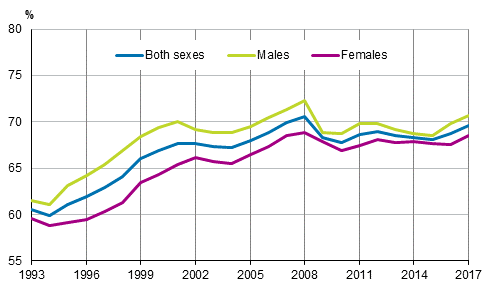
In 2017, the number of employed persons aged 15 to 74 in Finland was 2,473,000, which was 25,000 higher than in 2016 (Figure 2). The number of employed persons increased in all quarters and especially in the fourth quarter compared to the corresponding quarters of the previous year. The employment rate for the population aged 15 to 74 was 60.1 per cent, and that for persons aged 20 to 64 was 74.0 per cent in 2017. Employment rates with different age group divisions are available in the database tables of the Labour Force Survey: 001 Population by labour force status, sex, and age .
Figure 2. Number of employed persons by sex in 1993 to 2017, persons aged 15 to 74
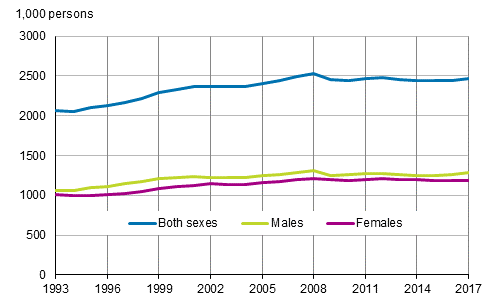
Women's employment also started growing
There were 16,000 more employed men and 9,000 more employed women aged 15 to 74 in 2017 than in 2016. Women's employment made an upturn in 2017 for the first time since 2012. Men's employment started growing already in 2016 (Figure 3).
Figure 3. Change from the previous year in the number of employed persons by sex in 2003 to 2017, persons aged 15 to 74
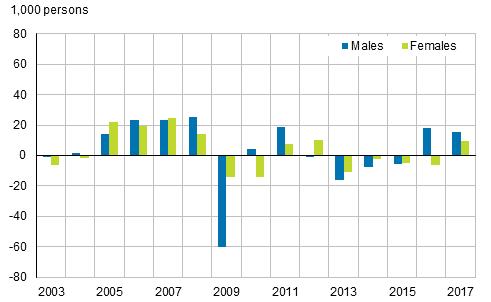
The employment rate grew in 2017 from 2016 in nearly all age groups, most for persons aged 45 to 54 (Figure 4). The employment rate of persons aged 55 to 64 has grown continuously since 2010, while those of persons aged under 55 have not reached the level of 2008 once. Among the population aged 65 to 74, the employment rate remained at the 2016 level at 10.6 per cent in 2017.
Figure 4. Employment rates by age group in 1993 to 2017, %
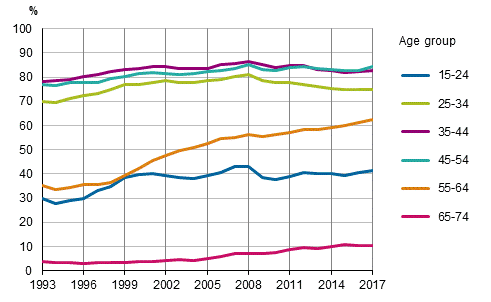
Number of employed persons increased in business activities, construction and education, decreased in trade and human health and social work activities
In 2017, the industry of business activities (M, N) made and upturn and grew by 12,000 persons and education (P) by 8,000 persons. Growth in the construction (F) industry continued with 8,000 persons. Financial and insurance activities and real estate activities (K, L) grew by 6,000 employees. In information and communication activities (J), the number of employed persons grew by 4,000, and other service activities (R-U) also continued growing by 4,000 employees.
Compared with the previous year, the number of employed persons decreased in wholesale and retail trade (G) by 9,000 persons. In human health and social work activities (Q), the number of employed persons declined by 5,000. This decrease was directed at human health activities and residential care activities, while the number of employed increased slightly in social work activities without accommodation. In manufacturing (C), the number of employed persons decreased especially in the manufacture of wood, paper and paper products. In agriculture, forestry and fishing and in mining (A, B), as well as in transportation and storage (H) the number of employed persons decreased slightly.
Figure 5 shows the change from the previous year in the number of employed persons by industry in 2016 and 2017.
Figure 5. Change from the previous year in the number of employed persons by industry in 2016 and 2017, persons aged 15 to 74

Employment increased in the private sector by 10,000 persons, and in the public sector by 17,000 persons in 2017.
There were 2,147,000 employees in 2017, which was 43,000 more than in the previous year. In 2017, the total number of self-employed persons and unpaid family workers declined and totalled 326,000 of which 10,000 were unpaid family workers. The number of self-employed persons and unpaid family workers decreased by 18,000 and their share among employed persons declined by one percentage point to 13 per cent.
In 2017, there were 97,000 self-employed with employees of which around three-quarters were men and close on one-quarter women. There were 218,000 self-employed without employees, of whom, 138,000 were men and 80,000 women. The number of self-employed without employees decreased by 13,000 from 2016. Of them, 12,000 were men.
Examined by socio-economic group, the number of upper-level employees increased by 29,000 persons of whom 19,000 were men and 10,000 women. The number of lower-level employees grew by 6,000 women and declined by 3,000 men. The number of men in manual worker occupations increased by 14,000 and the number of women decreased by 2,000 from 2016 to 2017.
The socio-economic structure of male and female employees has remained relatively unchanged in recent years. Still, over one-half of women, 55 per cent, worked as lower-level employees, and 44 per cent of men, in worker occupations. Close on one-fifth of women worked in manual worker occupations in 2017. For men, the situation has changed slightly: the share of lower-level employees among male employees decreased by one percentage point to 24 per cent and the share of upper-level employees grew by one percentage point to 32 per cent compared to 2016. The socio-economic structure of female employees remained unchanged.
Number of hours worked remained unchanged
In 2017, a total of 4 billion hours were worked in the national economy, which is the same as in 2016. In 2017, the average annual number of hours worked by an employed person was 1,634 hours, whereas in 2016 the respective figure was 1,639 hours.
In 2017, the number of underemployed persons was, on average, 137,000, which was 8,000 less than in 2016. Underemployed persons refer to persons working involuntarily part-time or a shortened working week or that have not had work due to a low number of orders or customers or due to being temporarily laid off. Underemployed persons were women (62%) more often than men.
2.2 Number of unemployed and persons in disguised unemployment decreased in 2017
Unemployment continued decreasing in 2017. In 2017, the average number of unemployed was 234,000. The number of unemployed men was 125,000 and that of women 109,000. Unemployment among both men and women decreased slightly.
The unemployment rate among persons aged 15 to 74 was, on average, 8.6 per cent in 2017, having been 8.8 per cent in 2016. The unemployment rate of men declined to 8.9 per cent and that of women to 8.4 per cent.
Besides unemployed persons, there were 143,000 persons aged 15 to 74 classified as being in disguised unemployment, who would and could have accepted work, but had not looked for it actively. The number of persons in disguised unemployment decreased by 12,000 compared with 2016 (Figure 6). The total number of unemployed persons and persons in disguised unemployment was 377,000 in 2017, which was 15,000 lower than one year before. More about persons in disguised unemployment can be found in Section 4 Inactive population.
Figure 6. Unemployed persons and persons in disguised unemployment in 2003 to 2017, persons aged 15 to 74
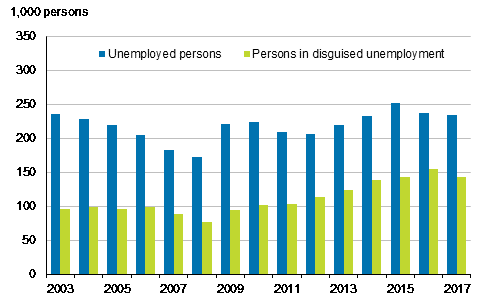
In 2017, the unemployment rate for young people aged 15 to 24, that is, the proportion of the unemployed among the labour force stood at 20.1 per cent, which was the same as one year previously. The unemployment rate decreased among those aged 35 to 44 and those aged 45 to 54. Altogether, 66,000 young persons aged 15 to 24 were unemployed in 2017, which was 28 per cent of all unemployed persons. In 2016, the corresponding figure was 65,000, or 27 per cent of all unemployed persons. The share of unemployed people aged 15 to 24 among the population in the same age group was 10.4 per cent in 2017 (Figure 8) having been 10.2 per cent in 2016.
Figure 7. Unemployment rates by age group in 1993 to 2017, %
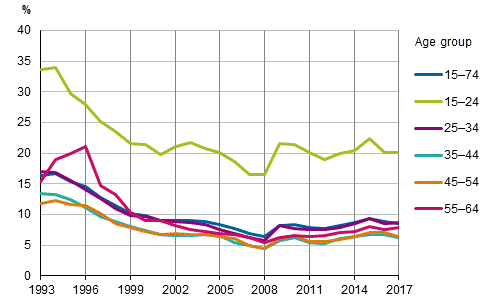
Figure 8. Shares of employed and unemployed persons, and inactive population of age group in 2017, %
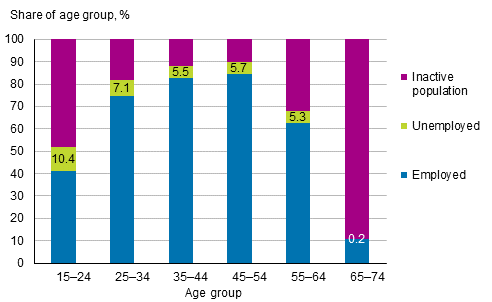
2.3 The labour force turned to growth
In 2017, the number of persons aged 15 to 74 in Finland was 4,114,000, which was 5,000 higher than in 2016. Simultaneously, the number of population aged between 15 to 64 decreased by 12,000. The population grew most in the age group 65 to 74, in total by 16,000 persons from the previous year. The age group 55 to 64 was still largest even though it decreased by 3,000 persons (Figure 9).
The labour force, i.e. the employed and unemployed in total, grew by 20,000 persons from 2016. The share of the active population among persons aged 15 to 74, increased from 65.3 per cent in 2016 to 65.8 per cent in 2017.
In 2017, the number of persons in the inactive population aged 15 to 74 was 1,407,000, which was 17,000 fewer than in 2016. More about the inactive population can be found in Section 4 Inactive population.
Figure 9. Population of working age and active population by age group in 2017
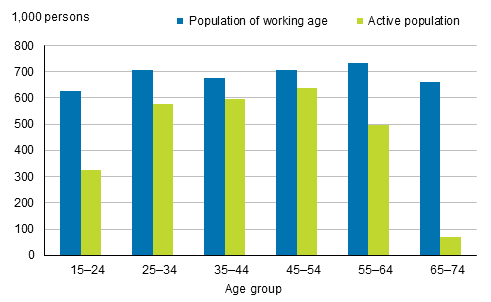
2.4 Number of new employment contracts of under one year's duration increased in 2017
Temporary employment still more widespread among women than men
In 2017, the average number of employees in Finland was 2,147,000, which was 43,000 higher than in 2016. In all, 345,000 employees had temporary employment contracts, 204,000 of whom were women and 141,000 men (Figure 10). The number of temporary employees grew by 12,000 from the year before.
Figure 10. Number of temporary employees by sex in 2003 to 2017, persons aged 15 to 74
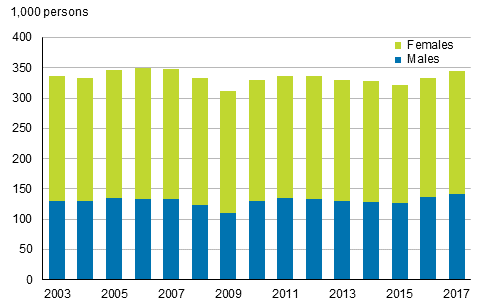
Eighty-four per cent of all employment contracts of employees were permanent and 16 per cent temporary in 2017. Compared to 2016, the shares remained unchanged. Temporary employment relationships are more common for women than for men. Nineteen per cent of female employees and 13 per cent of male employees worked in a temporary employment relationship in 2017. (Figure 11.)
Figure 11. Share of temporary employees of all employees by sex in 2003 to 2017, persons aged 15 to 74, %
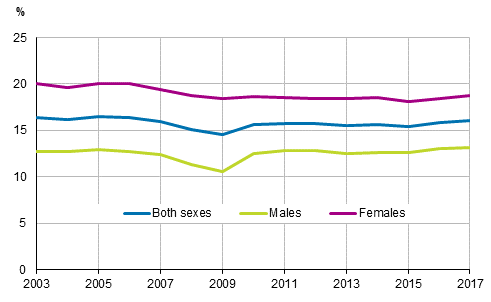
Two-thirds of temporary employees would want a permanent job
There were 345,000 temporary employed persons in 2017 of which 232,000 would have wanted a permanent job. Of them, 145,000 were women and 86,000 men. Lack of permanent work was the reason why 67 per cent of all temporary employees worked in temporary jobs.
Lack of permanent work was most common for temporary employees aged 35 to 44. In this age group, 88 per cent of women and 78 per cent of men said that lack of permanent work was the reason for working in a temporary job. In this group, the number of women grew by 6,000 from 2016 and the number of men remained unchanged.
One-quarter of temporary employees did not want a permanent job. A majority of these were young people aged 15 to 24, typically summer workers. Other reasons for temporary work were trial period and practical training not connected to studies.
Over one-half of new employment contracts were temporary, more often for women than men
There were 461,000 employees whose employment relationship had lasted less than a year in 2017, which was 29,000 more than in 2016. (Figure 12.)
Figure 12. Employees with employment contracts of under one year's duration in 2003 to 2017, persons aged 15 to 74
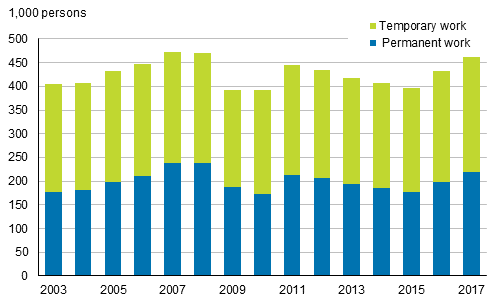
Fifty-two per cent of the employment contracts of under one year's duration were temporary, while the corresponding share was 54 per cent in 2016. There was a clear difference between women and men in whether a new employment relationship was fixed-term or permanent. Forty-five per cent of men’s and 59 per cent of women’s new employment relationships were temporary in 2017. Men’s new employment relationships were temporary less often than before, as in 2016 altogether 48 per cent of men’s new employment contracts were temporary. For female employees the change was slightly similar, in 2016 altogether 60 per cent of women’s new employment contracts were temporary.
Two per cent of employees did temporary agency work
Temporary agency work refers to an employment relationship in which an employee works via an enterprise which provides or hires out labour force. Data on temporary agency work have been collected in the Labour Force Survey since 2008. Temporary agency workers made up two per cent of all employees in 2017.
In 2017, the average number of persons doing temporary agency work was 41,000, which was 3,000 more than in 2016. The number of men doing temporary agency work was 24,000 and that of women 17,000. The number of persons doing temporary agency work has grown steadily since 2014 but temporary agency work is still a rather marginal form of working on the Finnish labour markets.
Temporary agency workers were employed by several industries. It was most common in manufacturing and electricity, heat and water supply, waste management, etc. (C–E), wholesale and retail trade (G) and accommodation and food service activities (I). Compared with 2016, temporary agency work increased especially in manufacturing industries.
2.5 Number of persons working part-time grew further
Over one-fifth of female employees work part-time
In 2017, altogether 408,000 persons, which is 17 per cent of all employed persons worked part-time. This was 9,000 employed persons more than in 2016. In 2017, the number of part-time working employees was 332,000, which was 10,000 more than in the year before. The Labour Force Survey data on part-time employment is based on the respondents’ own reporting. The following only concerns part-time employees.
Part-time employment was more widespread among women than men. Twenty-one per cent of female employees worked part-time in 2017, or 227,000 women and 10 per cent of male employees, 104,000 men. The share of male employees working part-time remained the same as in 2016, for women, the share of part-time employees, in turn, grew by one percentage points, or some 9,000 persons. In recent years, part-time work has increased in particular among women. (Figures 13 and 14.)
Part-time work was common among the youngest and especially among the oldest employees. Forty-four per cent of young employees aged 15 to 24 worked part-time in 2017, mainly due to studies. Sixty-three per cent of employees aged 65 to 74 worked part-time in 2017.
Approximately three-quarters (76%) of part-time employees worked in the private sector. Part-time work was most common in the industries of wholesale and retail trade (G), and human health and social work activities (Q). The share of part-time employees of all employees in the industry was the largest, or 42 per cent, in retail trade (excl. motor vehicle trade).
Figure 13. Part-time employees by sex in 2003 to 2017, persons aged 15 to 74
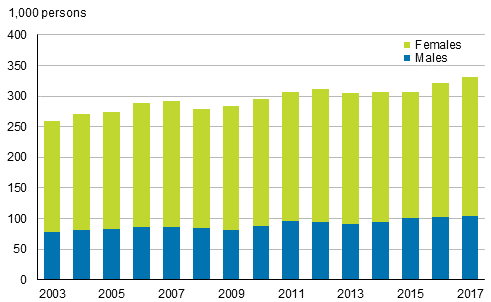
Figure 14. Share of part-time employees among employees by sex in 2003 to 2017, persons aged 15 to 74, %
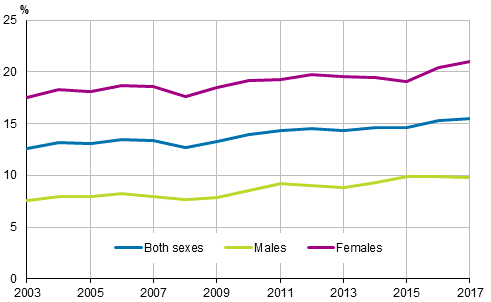
For women, lack of full-time work most common reason for part-time employment, for men studying
Working part-time suits the life situation of many of those who are employed part-time. However, part-time employment can be viewed as one form of underemployment in cases where the employee has not succeeded in finding full-time work even if he/she had wanted one.
In 2017, there were 104,000 part-time employees who wanted to work full-time. Of them, 73,000 were women and 31,000 men. The number of women working part-time involuntarily remained unchanged from 2016, the number of men decreased a little. Lack of full-time employment was the most common reason for working part-time among female employees. Nearly one-third of women working part-time reported this as their reason. For men, the main reason for working part-time was studying, which was reported by good one-third of men working part-time as the reason.
Other reported reasons related to life situation were caring for children or relatives, and health reasons. Nearly all of those who reported caring for children or relatives as the reason for working part-time were women. Of young people aged 15 to 24, two-thirds reported studying as the reason for working part-time.
2.6 Different forms of working among the employed
Figure 15 classifies various forms of working. The figure shows that full-time paid work based on an employment contract valid until further notice was still in 2017 by far the most common form of working in Finland among those aged 15 to 74. Sixty-four per cent of employed persons aged 15 to 74 worked in a permanent full-time employment relationship in 2017. Of them, 716,000 were women and 855,000 were men. The number of men aged 15 to 74 working in a permanent full-time employment relationship grew by 25,000 persons while the corresponding number of women remained almost unchanged. (Figure 15.)
Figure 15. Different forms of working among employed persons aged 15 to 74 in 2017
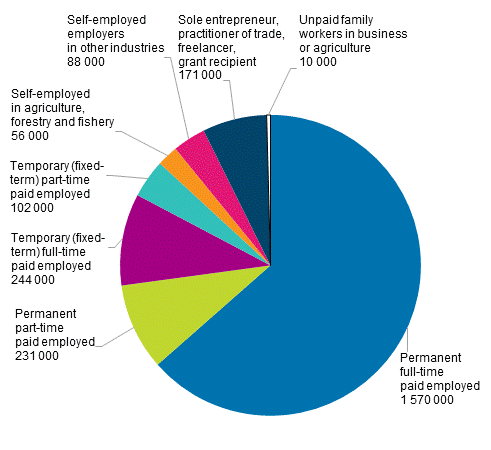
One-tenth of employed persons aged 15 to 74 worked full-time in a fixed-term employment relationship. Four per cent of employed persons did part-time work on a temporary employment contract. Their number grew by 6,000 from the previous year. Nine per cent of employed persons worked part-time under an employment contract valid until further notice. Their number grew by 4,000 persons.
The share of persons working as sole entrepreneurs, own-account workers, freelancers and grant recipients (excl. agriculture and forestry) among all employed persons aged 15 to 74 was seven per cent in 2017, which amounted to some 171,000 persons. Of them, 102,000 were men and 69,000 women. This group decreased by 12,000 persons from 2016. Of all employed persons aged 15 to 74, in total 3.5 per cent were self-employed employers (excl. agriculture and forestry), and around two per cent were self-employed in agriculture, forestry and fishery. The number of self-employed in agriculture, forestry and fishery has long been falling but in 2017 it remained at the same level as in 2016. (Table 1.)
Table 1. Different forms of working among persons aged 15 to 74 by sex in 2017, percentage share of all employed persons
| Males | Females | Both sexes | |
| Permanent full-time paid work | 69,1 | 61,5 | 63,5 |
| Permanent part-time paid work | 5,5 | 14,0 | 9,4 |
| Temporary full-time paid work | 8,5 | 12,0 | 9,9 |
| Temporary part-time paid work | 2,9 | 5,5 | 4,0 |
| Self-employed in agriculture,forestry and fishery | 3,4 | 1,2 | 2,3 |
| Self-employed employers in other industries | 5,8 | 2,0 | 3,5 |
| Sole entrepreneur, own-account worker, freelancer, grant recipient | 7,9 | 6,7 | 6,9 |
| Unpaid family worker in an enterprise / farm | . | . | . |
Source: Labour Force Survey 2017. Statistics Finland
Inquiries: Ulla Hannula 029 551 2924, Pertti Taskinen 029 551 2690, tyovoimatutkimus@stat.fi
Director in charge: Jari Tarkoma
Updated 12.4.2018
Official Statistics of Finland (OSF):
Labour force survey [e-publication].
ISSN=1798-7857. Employment and unemployment 2017,
2 Employment and unemployment in 2017
. Helsinki: Statistics Finland [referred: 19.4.2025].
Access method: http://stat.fi/til/tyti/2017/13/tyti_2017_13_2018-04-12_kat_002_en.html

